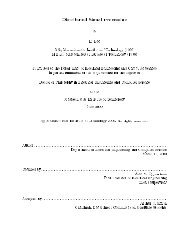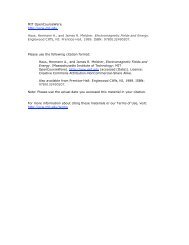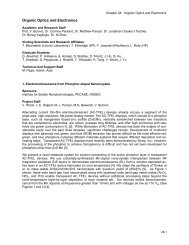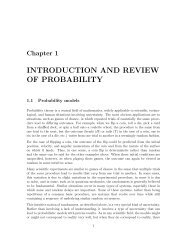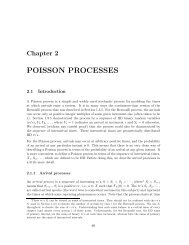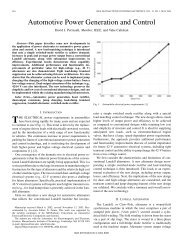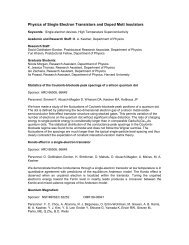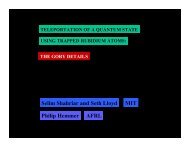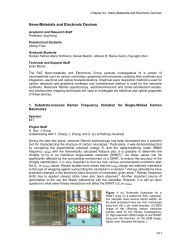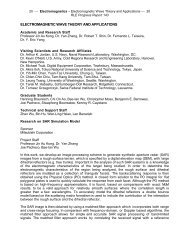RLE Progress Report No - Research Laboratory of Electronics - MIT
RLE Progress Report No - Research Laboratory of Electronics - MIT
RLE Progress Report No - Research Laboratory of Electronics - MIT
You also want an ePaper? Increase the reach of your titles
YUMPU automatically turns print PDFs into web optimized ePapers that Google loves.
4. Variational Principle for Modes With Resonant Absorption<br />
Sponsors:<br />
National Science Foundation — Grant ATM 98-06328<br />
Project Staff:<br />
Pr<strong>of</strong>. Abraham Bers, Dr. Abhay K. Ram, Meng-Jiao Wu, Ante Salcedo<br />
The problem <strong>of</strong> resonant absorption modes along a uniform magnetic field in a plasma whose density<br />
is depleted across the magnetic field (see Section 3 <strong>of</strong> this progress report) amounts to a complex<br />
eigenvalue problem for an inhomogeneous waveguide. In the electrostatic limit, the differential<br />
equation for the potential was presented in Eqs. (7)–(10) in our last report. 1 [<strong>No</strong>te that the start <strong>of</strong><br />
the first term on the right-hand-side <strong>of</strong> Eq. (9) should read (−ω ce /ω) rather than (−ω/ω ce ).] For a<br />
given frequency <strong>of</strong> interest, the differential equation can be regarded as an eigenvalue problem for<br />
the complex propagation constant, k z , along B ⃗ 0 . As indicated there, for a plasma density pr<strong>of</strong>ile,<br />
the differential equation is only solvable by numerical integration techniques. Another approach is<br />
to consider a variational principle for the complex k z eigenvalue. During the past year, we have<br />
explored this approach, and summarize here the results to date.<br />
The appropriate variational principle for electrostatic modes can be derived from Poisson’s equation<br />
for the small-amplitude electric field in a cold plasma<br />
∇·( ↔ K · ⃗E)= 0 (1)<br />
where K= ↔ K ↔ (⃗r T ,ω) is the permitivity tensor for a cold plasma in a magnetic field B ⃗ 0 = ẑB 0 ; 1 the<br />
plasma is assumed homogeneous in z, along B ⃗ 0 , but inhomogeneous in ⃗r T , transverse to B ⃗ 0 .<br />
Assuming the field dependence along B ⃗ 0 as exp(ik z z), splitting up ∇, K, ↔ and E ⃗ into components<br />
transverse and parallel to B ⃗ 0 , and letting E ⃗ = −∇Φ, we obtain from (1)<br />
∇ T · ( K ↔ T ·∇ T Φ)−kz 2 K ‖ Φ= 0 . (2)<br />
For a given ω, and appropriate transverse boundary conditions, (2) is an eigenvalue equation for kz 2 .<br />
Following standard procedures 2 for deriving a variational principle for kz 2 ,wefind<br />
∫ {K<br />
kz 2 A ⊥<br />
[(d ˆΦ/dr)<br />
]<br />
2 +(m 2 /r 2 )ˆΦ 2 + 2(m/r)χ x (d ˆΦ/dr)ˆΦ<br />
}<br />
da<br />
=<br />
− ∫ A K ˆΦ<br />
(3)<br />
‖ 2 da<br />
where we assumed inhomogeneity in r only, and thus Φ=ˆΦ(r) exp(imϕ), and that ˆΦ(r →∞) →0<br />
so that the bilinear concomitants vanish.<br />
To compare the results from (3) with results from numerically integrating the differential equation for<br />
Φ, we have applied this to a simple problem for which we can obtain an exact analytic result (see<br />
Section 3). For that case, we can use (3) with m= 0. To evaluate the eigenvalue for a frequency<br />
such that the resonance absorption occurs in the density gradient at x = x 0 , we use as a guess<br />
for the potential ˆΦ= C1 + C 2 ln (x − x 0 ) for 0



